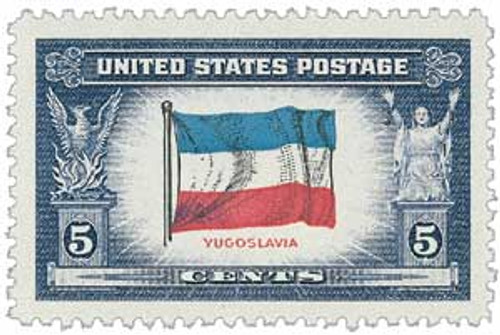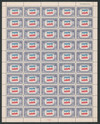
1943 Overrun Countries: 5c Flag of Yugoslavia
# 917 - 1943 Overrun Countries: 5c Flag of Yugoslavia
$0.60 - $45.00
U.S. #917
5¢ Flag of Yugoslavia
Overrun Countries Series
5¢ Flag of Yugoslavia
Overrun Countries Series
Issue Date: October 26, 1943
City: Washington, D.C.
Quantity: 14,999,646
Printed by: American Bank Note Company
Printing Method: Flat-Plate
Perforations: 12
Color: Blue violet, blue, dark rose, and black
City: Washington, D.C.
Quantity: 14,999,646
Printed by: American Bank Note Company
Printing Method: Flat-Plate
Perforations: 12
Color: Blue violet, blue, dark rose, and black
U.S. #917 is part of the Overrun Countries Series, which honors each of the nations invaded by Axis powers during World War II. It pictures the flag of Yugoslavia, which features blue, white, and red stripes and was adopted in 1922. The flag has since been changed to include a red star in the center.
Yugoslavia – History
After the Austro-Hungarians lost World War I, several countries were carved from the Empire to create a new country – Yugoslavia. Made up of Croatia, Slovenia, Bosnia and Herzegovina as well as the independent nations of Serbia and Montenegro, the new nation was created as a constitutional monarchy ruled by Alexander I.
During World War II, Yugoslavia was invaded by the Axis powers. A resistance group called the “Partisans,” led by Joseph Broz Tito, quickly gained support of the people, and aided by the Allies, freed the country from occupation. By the end of the war, Tito and the Communists controlled all of Yugoslavia.
After the Communists took control, many programs were introduced to encourage industrial growth and raise living standards. Many families were able to own a car, a television, and other things previously considered luxuries.
These Stamps Brought Hope to Overrun Countries of WW II
After receiving several designs from artists who felt the current U.S. postage stamps were unattractive, President Franklin Roosevelt began to consider the types of stamps he wanted to issue. He sought to show the world that America was in this war to achieve world peace, not military dominance. With this in mind, the President suggested the U.S. issue a series of stamps picturing the flags of all the overrun nations in Europe.
In the border surrounding each flag, Roosevelt suggested picturing the Phoenix – an ancient symbol of rebirth. He believed “It might tell those suffering victims in Europe that we are struggling for their own regeneration.” The other side of each flag pictured a kneeling woman “breaking the shackles of oppression.”
When the time came to print the stamps, the Bureau of Engraving and Printing was unable to print the multiple colors needed for each flag, so the American Bank Note Company received a special contract for this series.
Additionally, a 5¢ denomination – the foreign rate for first class postage – was chosen so the stamps could be used on overseas mail. The stamps were printed in relatively small quantities and were in high demand as soon as they were issued, with stocks across the country running out almost as soon as they were released.
FDR – The Stamp-Collecting President
President Franklin Roosevelt was instrumental in the design and issuance of U.S. #917. Introduced to stamp collecting at a young age by his mother, Franklin Delano Roosevelt turned to his collection throughout his life to relax and unwind.
Elected President four times, Roosevelt served in the nation’s highest office longer than any other chief executive – 12 years. During those 12 years, Roosevelt shared his love of stamps with the nation, personally approving each of more than 200 stamp designs. He suggested topics, rejected others, and even designed some himself. It was his aim to use stamps not just to send mail but also to educate Americans about our history. And as he reluctantly entered America into World War II, he saw these stamps as an outlet to raise spirits and bring hope.
U.S. #917
5¢ Flag of Yugoslavia
Overrun Countries Series
5¢ Flag of Yugoslavia
Overrun Countries Series
Issue Date: October 26, 1943
City: Washington, D.C.
Quantity: 14,999,646
Printed by: American Bank Note Company
Printing Method: Flat-Plate
Perforations: 12
Color: Blue violet, blue, dark rose, and black
City: Washington, D.C.
Quantity: 14,999,646
Printed by: American Bank Note Company
Printing Method: Flat-Plate
Perforations: 12
Color: Blue violet, blue, dark rose, and black
U.S. #917 is part of the Overrun Countries Series, which honors each of the nations invaded by Axis powers during World War II. It pictures the flag of Yugoslavia, which features blue, white, and red stripes and was adopted in 1922. The flag has since been changed to include a red star in the center.
Yugoslavia – History
After the Austro-Hungarians lost World War I, several countries were carved from the Empire to create a new country – Yugoslavia. Made up of Croatia, Slovenia, Bosnia and Herzegovina as well as the independent nations of Serbia and Montenegro, the new nation was created as a constitutional monarchy ruled by Alexander I.
During World War II, Yugoslavia was invaded by the Axis powers. A resistance group called the “Partisans,” led by Joseph Broz Tito, quickly gained support of the people, and aided by the Allies, freed the country from occupation. By the end of the war, Tito and the Communists controlled all of Yugoslavia.
After the Communists took control, many programs were introduced to encourage industrial growth and raise living standards. Many families were able to own a car, a television, and other things previously considered luxuries.
These Stamps Brought Hope to Overrun Countries of WW II
After receiving several designs from artists who felt the current U.S. postage stamps were unattractive, President Franklin Roosevelt began to consider the types of stamps he wanted to issue. He sought to show the world that America was in this war to achieve world peace, not military dominance. With this in mind, the President suggested the U.S. issue a series of stamps picturing the flags of all the overrun nations in Europe.
In the border surrounding each flag, Roosevelt suggested picturing the Phoenix – an ancient symbol of rebirth. He believed “It might tell those suffering victims in Europe that we are struggling for their own regeneration.” The other side of each flag pictured a kneeling woman “breaking the shackles of oppression.”
When the time came to print the stamps, the Bureau of Engraving and Printing was unable to print the multiple colors needed for each flag, so the American Bank Note Company received a special contract for this series.
Additionally, a 5¢ denomination – the foreign rate for first class postage – was chosen so the stamps could be used on overseas mail. The stamps were printed in relatively small quantities and were in high demand as soon as they were issued, with stocks across the country running out almost as soon as they were released.
FDR – The Stamp-Collecting President
President Franklin Roosevelt was instrumental in the design and issuance of U.S. #917. Introduced to stamp collecting at a young age by his mother, Franklin Delano Roosevelt turned to his collection throughout his life to relax and unwind.
Elected President four times, Roosevelt served in the nation’s highest office longer than any other chief executive – 12 years. During those 12 years, Roosevelt shared his love of stamps with the nation, personally approving each of more than 200 stamp designs. He suggested topics, rejected others, and even designed some himself. It was his aim to use stamps not just to send mail but also to educate Americans about our history. And as he reluctantly entered America into World War II, he saw these stamps as an outlet to raise spirits and bring hope.


















